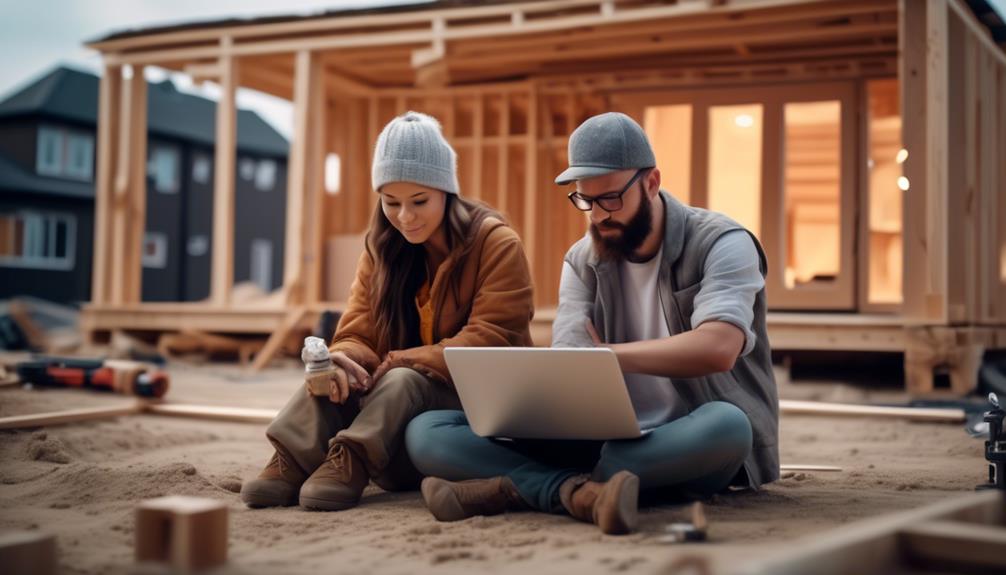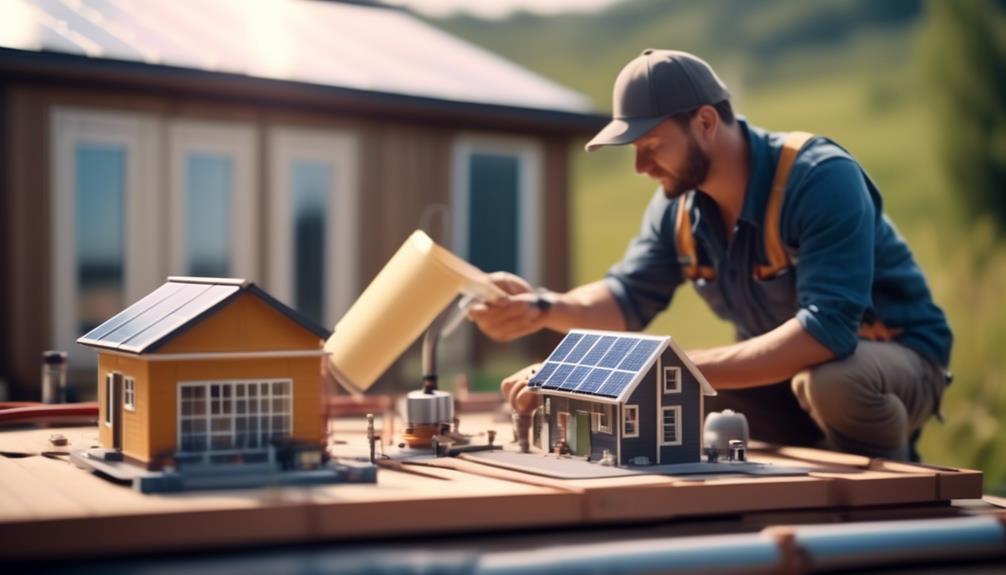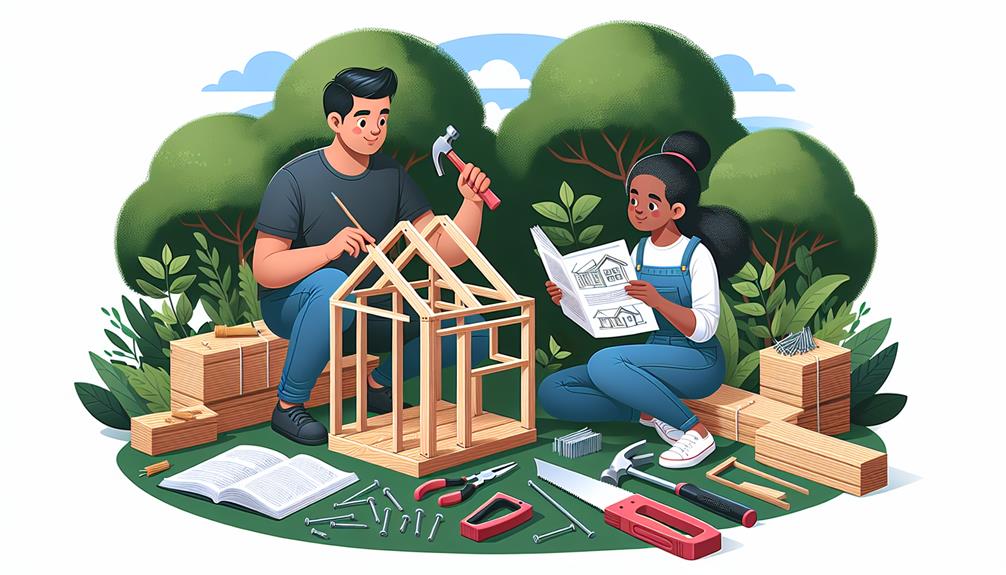Rome wasn't built in a day, and neither will your tiny home be, especially when you're starting from scratch with no prior experience. You're embarking on a journey that's as much about personal growth as it is about construction.
As you begin, you'll need to arm yourself with a solid plan, ensuring you've considered the intricacies of design, location, and legality. You'll have to source materials that fit your budget without compromising on quality.
Learning the basics of construction is non-negotiable, from securing a robust foundation to erecting the walls that will define your living space. With every nail you drive and every board you place, you'll be building more than just a house; you're crafting a sanctuary that reflects your values of simplicity and sustainability.
Stay with me as we unpack the essentials of turning your tiny house dream into a doable reality, step by manageable step, ensuring you avoid common pitfalls that could turn your labor of love into an unwelcome headache.
Key Takeaways
- Careful planning and preparation are crucial before starting the construction of a tiny home.
- Sourcing materials and seeking guidance from knowledgeable individuals can ensure a smooth building process.
- Learning construction basics, including local building codes and regulations, is essential for a successful build.
- Installing utilities and adding finishing touches, such as selecting compact appliances and incorporating decorative elements, can maximize space and create a personalized living environment.
Planning Your Build
Before you dive into construction, carefully select a tiny house plan that aligns with both your needs and legal requirements. When planning to build, it's a good idea to visualize your lifestyle in the space. Will it accommodate your daily activities? Consider this step by step, creating a building checklist that reflects your priorities.
Starting building a tiny house without a well-thought-out plan can lead to costly mistakes. Take time to plan, researching various tiny house plans that cater to innovation and functionality. Gather all necessary permits and approvals early on to ensure your process of building runs smoothly.
Sourcing Materials
As you transition from planning to execution, sourcing the right materials is a critical next step in building your tiny home. Start by researching and sourcing key items such as the trailer, windows, lumber, tools, and appliances. Don't hesitate to seek guidance from knowledgeable friends or professionals who can provide insights into the tiny house building process.
Consider the logistics of moving materials to your build site, and align the ordering of supplies with your construction schedule to avoid delays. Ensure that you have all the necessary tools and materials on hand before you start the build process.
This comprehensive guide reflects the steps I took to build with efficiency. Remember, smart sourcing materials is foundational to the success of your tiny home project.
Learning Construction Basics

Dive into the essentials of construction by first familiarizing yourself with the local building codes and regulations that will shape your tiny home project. While constructing your tiny house, it's crucial to have a solid foundation of knowledge. Here are some key points to focus on:
- Begin with a reliable step-by-step guide or an excellent tutorial I found to understand the process from the ground up.
- Master the basics of framing, including the tiny house floor and walls.
- Learn about roof design options and the techniques for building your tiny, weatherproof top.
- Get hands-on with the electrical and plumbing systems to ensure your tiny homes are both functional and safe.
Tiny House Framing
When framing your tiny home, it's essential to start by securing the walls with metal bracing, ensuring a solid and stable structure as you move forward. Prioritize a robust frame for your tiny house interior to support your innovative House Design. As you build a tiny house, particularly if it's one of the Tiny Houses on wheels, remember that a successful tiny home relies on precision.
| Step | Tip |
|---|---|
| Wall Framing | Reinforce joints for a sturdy tiny house trailer foundation. |
| Roof Framing | Opt for a simple design; frame and sheath with plywood or OSB. |
| Sequence | Set up walls before the roof to streamline construction. |
| Stability | Use metal bracing for a secure build, essential in the tiny house movement. |
Keep these pointers in mind to ensure a safe and successful build as you join the tiny house movement.
Installing Utilities

Before you progress with adding walls and a roof to your tiny home, it's crucial to plan and install the utilities, including plumbing, electrical, gas lines, and HVAC systems, to ensure they're seamlessly integrated into your design. When you build your tiny house, you'll find that the right approach to installing utilities can make or break the functionality and comfort of your living space.
- Location Planning: Carefully map out where to place utilities for optimal space usage and efficiency.
- Structural Reinforcement: Ensure your tiny house on wheels can handle the utility installations with proper bracing.
- Roofing Considerations: Opt for a simple roof and durable roofing material to protect your utility systems from the elements.
- Off-grid Innovations: Explore sustainable options for power and water to park your tiny home virtually anywhere.
From start to finish, ensure every step you take contributes to a stable and livable tiny home.
Finishing Touches
Now that you've constructed your tiny home's frame and installed the essentials, it's time to give it character with finishing touches.
You'll select interior decor that not only matches your style but also optimizes your compact space.
On the exterior, choose durable finishes that protect your home while enhancing its curb appeal.
Selecting Interior Decor
To bring your tiny home to life, carefully select furniture and decor that not only maximize space but also infuse functionality into every corner. As you live in a tiny space, every item must be chosen with care. Here are some innovative ideas to consider:
- Multipurpose Furniture: Opt for items that serve dual purposes, like a sofa that turns into a guest suite.
- Neutral Palette: Choose light colors for the walls and Roof to create an airy feel and see how much more open your space can appear.
- Smart Storage: Make sure every piece, whether it's a bookshelf or a bed, offers extra storage to fit all your essentials.
- Compact Appliances: Select really compact appliances that fit your lifestyle, just like you'd fit a large shed into a small backyard.
Exterior Aesthetic Enhancements
Having considered the interior decor of your tiny home, let's focus on the exterior where thoughtful touches can significantly enhance curb appeal.
When you find a place for your tiny dream home, every square foot counts. Start with decorative trim or moldings; they're a good place to start for that polished look that says 'big in a tiny.'
Incorporate window boxes to add a bit of a guest-welcoming greenery and color. Explore unique siding options like cedar shingles for a look that's fascinating to see.
Outdoor lighting isn't just practical; it also accentuates your home's best features at night. Lastly, personalize your entryway with a custom door or porch.
These exterior aesthetic enhancements make your tiny house feel like a grand achievement on the land for a tiny footprint.
Frequently Asked Questions
Can a Beginner Build a Tiny House?
Yes, you can build a tiny house as a beginner. Start with design simplicity, use starter kits, understand zoning laws, gather tool essentials, source materials wisely, attend skill workshops, follow building codes, and prioritize safety precautions.
What Is the Easiest Tiny Home to Build?
The easiest tiny home you'll build uses prefab options, like kit homes or shipping containers. Embrace minimalist cabins or micro cottages with pre-cut materials; a simple studio design or a unique dome home works wonders.
How Long Does It Take One Person to Build a Tiny House?
Building your tiny house solo, you'll face a steep learning curve. Time estimation hinges on skill assessment, material acquisition, and weather impact. Expect scheduling challenges as you navigate construction phases at your project's pace.
How to Build Tiny House Cheap?
To cut corners on costs, start with budget planning and material sourcing. Opt for simple designs, DIY kits, and reclaimed materials. Join community workshops, borrow tools, use prefabricated components, and seek volunteer assistance.
Conclusion
Now you've laid the groundwork for a cozy abode that defies the norms of modern McMansions. As you hammer the last nail and paint the final stroke, bask in the triumph of creating something monumental from mere whispers of an idea.
Your journey from blueprint to tiny haven embodies the adage, 'Rome wasn't built in a day,' but your dedication has proven that a tiny home, built with heart and grit, can indeed rise in far less time.

